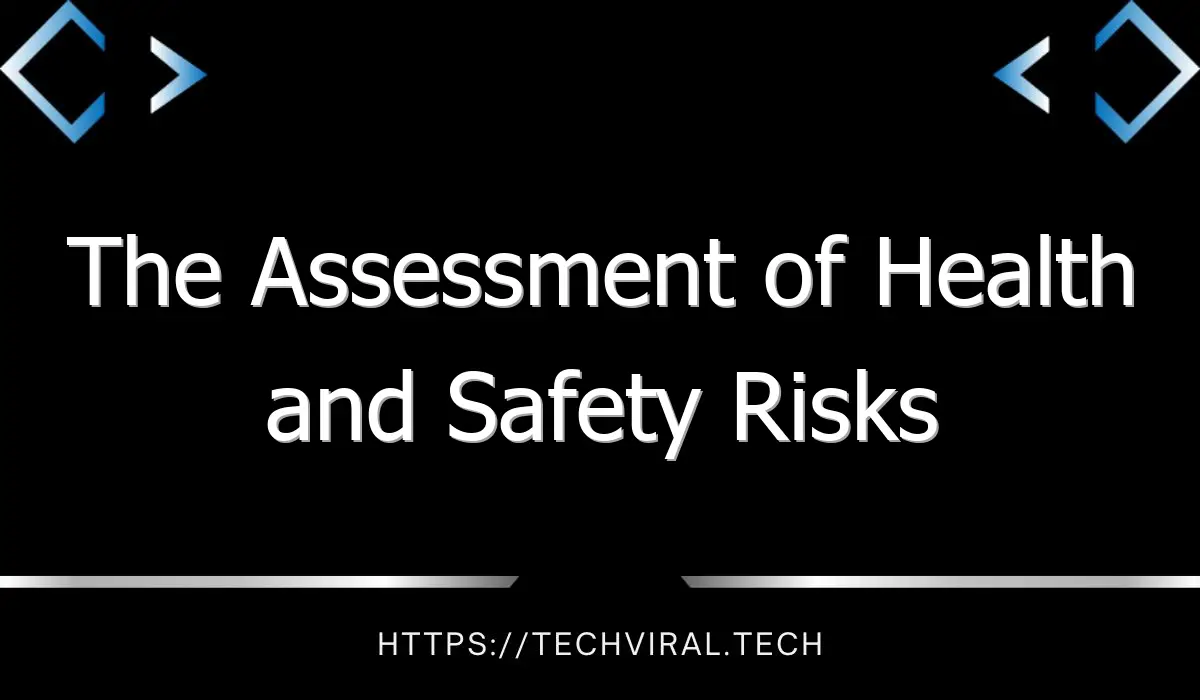The Assessment of Health and Safety Risks
The Assessment of health and safety risks is the process for identifying potential hazards in the workplace. There are many ways to approach the process. It is important to document your findings formally. Using a heat map or risk assessment matrix can help you compare hazards and prioritize them. This type of analysis also considers the likelihood of an incident occurring.
Process of assessing health and safety risks
Risk assessment involves considering a number of factors, including the impact of an accident on an individual, the health and safety of employees, and the environment. It also takes into account the business objectives and culture of the organization to determine how much risk is acceptable. For example, a company that is exposed to risks relating to fire, electrical shock, or other serious injury should have a policy that limits the use of flammable materials in its workplace.
A health and safety risk assessment must involve all employees, since they can provide important insights into the hazards they face in their workplace. This way, they can also offer suggestions for how the risks can be reduced. The assessment should be carried out by a multidisciplinary team and involve employees from all areas of the organization. The first step in the process is to identify all hazards present in the workplace. This can be done by walking around the premises and reading manufacturer’s manuals. Another way to identify hazards is to ask employees about any incidents that occur.
The health and safety risk assessment involves identifying all potential hazards and risks in an organization. These risks are then tracked and prioritized, so that practical solutions can be developed to eliminate or minimize these risks. The assessment is a vital part of an organization’s safety program. There are a variety of benefits to assessing health and safety risks. For example, it boosts employee morale, as it identifies people at risk.
Risk assessment must account for all aspects of the workplace, including the types of materials used in the workplace. It also includes whether the work is done indoors or outdoors. The risks of accidents occurring outside should be considered, as well as the hazards posed by intruders or customers. Employees may also be required to travel between locations, so personal safety should be taken into account as well.
Sources of information on workplace hazards
Information about workplace hazards can be found in a variety of sources, including manuals, chemical safety data sheets, warning labels, and signage. Many workplaces also have accident reports, which can provide insight into potential hazards. Industrial hygiene assessments can also provide information about trends in workplace injuries and illnesses. These records can also be used to prioritize corrective actions.
Information about workplace hazards may also be obtained through workplace surveys. Safety and health subject matter experts can also provide helpful information. The National Institute for Occupational Safety and Health (NIOSH) has outlined a hierarchy of controls that guides workplaces to implement effective hazard control measures. Hazards may be invisible to the untrained eye, but failing to notice them can result in serious injuries. Therefore, it’s essential to identify hazards and assess them consistently. For this, companies can use free incident report templates to keep a log of incidents and trends.
Workplace hazards are often unavoidable, but there are many ways to avoid them. In the first place, employers should provide proper training and education to workers. Employers should consider implementing a safety culture to prevent workplace hazards. For example, the use of a mobile elevated platform or fall protection gear could help reduce the risk of injury.
In addition, workers may be exposed to hazardous chemicals. These include pesticides, acids, fumes, welding fumes, and fiberglass fibers. These hazards may be harder to detect, but they can cause aching muscles in the short-term. Additionally, chemical hazards are present when a worker comes in contact with a chemical preparation. Some chemical solutions are safe, while others may cause serious illness, breathing problems, or skin irritation.
Toxic chemicals must be properly stored and labeled to reduce the risk of exposure. Some workplaces may also have ventilation systems to remove hazardous vapors. Additionally, workers must be trained about the chemicals in their environments to minimize the risk. They should be taught about how to use these chemicals safely, how to store them properly, and wear appropriate safety gear.
Occupational health and safety professionals are well-versed in the various types of hazards that can be present in the workplace. This knowledge can be used to convince management to implement proper safety measures. By identifying the potential hazards and implementing the proper measures, they can create a safer and more productive work environment.
Workplaces are often exposed to chemicals that can be deadly. Inhaled or splashed, these corrosive materials can cause respiratory problems, eye damage, and even death. Because of the dangers, workplaces must have policies and procedures that outline what needs to be done to prevent workplace accidents.
In a recent study conducted in Odisha, India, researchers examined the hazards that employees were exposed to at their workplace. They reviewed department procedures manuals, work instructions, and standards of operations to identify the most common health risks. Employees’ medical records were also reviewed.
Importance of a formal record of risk assessments
When carrying out health and safety risk assessments, it is essential that the findings are documented. These reports should be readily accessible for everyone, and should document the main findings and actions taken to minimise the risks. They should be written in plain language, and should be updated whenever new working practices or machinery are introduced.
The risks identified must be evaluated to determine the likelihood and severity of harm to workers. These assessments should take into account the number and type of people exposed to the risks, as well as their levels of competence. They should also consider the condition and availability of first-aid provisions. The risk assessment should be reviewed regularly to ensure that all controls are working effectively.
The aim of any workplace is to keep staff safe. Accidents and ill health can ruin people’s lives and hurt businesses. They can cause machinery to be damaged or lose output, increase insurance costs, and even result in court cases. Risk assessments help reduce the risk of accidents and protect people’s health and safety.
The health and safety risk assessment should identify the most important hazards that should be addressed first. These hazards are the ones with the most consequences for most people. For instance, institutions that use macaques should consider the risk of B virus exposure. They should also take appropriate measures to minimize other forms of harm, such as splash barriers.
Keeping a formal record of health and safety risk assessment records is crucial for any company. In fact, it is a legal requirement for companies with five or more employees. However, it is also important to keep a record of the results. This document is an important tool in developing effective health and safety policies.
The Health and Safety Authority provides guidance and templates for completing a risk assessment. These guides outline the procedures for preparing a Risk Assessment and safety statement, and outline the key personnel. They also provide information and checklists for identifying risks. The Safety Statement should also outline the actions taken to mitigate these risks.
In addition to health and safety risk assessments, employers should also implement a Safety Statement. They are legally obliged to implement these plans and procedures to ensure the safety of their employees. An employer who fails to comply with these regulations can face prosecution. The Health and Safety Authority also regularly inspects workplaces to inspect their health and safety management systems and procedures. If they find a breach of the law, the employer will be required to review the Safety Statement and implement any changes in their procedures.




